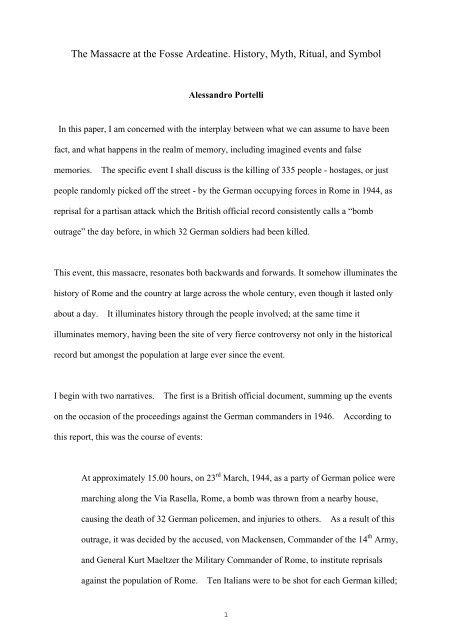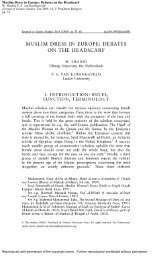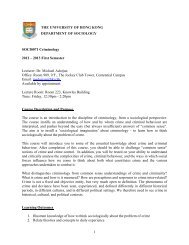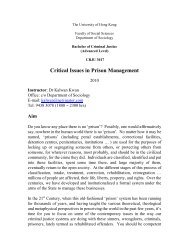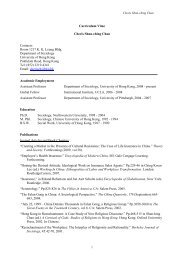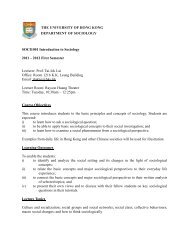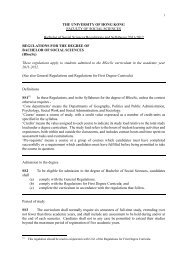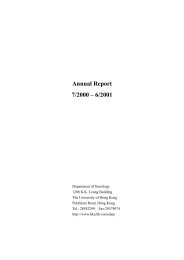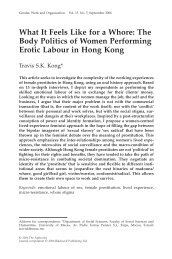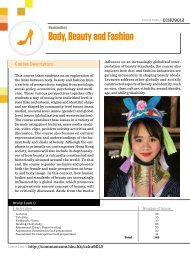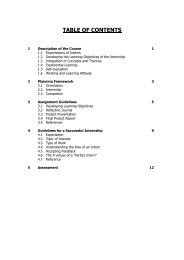The Massacre at the Fosse Ardeatine. History, Myth, Ritual, and ...
The Massacre at the Fosse Ardeatine. History, Myth, Ritual, and ...
The Massacre at the Fosse Ardeatine. History, Myth, Ritual, and ...
You also want an ePaper? Increase the reach of your titles
YUMPU automatically turns print PDFs into web optimized ePapers that Google loves.
<strong>The</strong> <strong>Massacre</strong> <strong>at</strong> <strong>the</strong> <strong>Fosse</strong> Arde<strong>at</strong>ine. <strong>History</strong>, <strong>Myth</strong>, <strong>Ritual</strong>, <strong>and</strong> Symbol<br />
Aless<strong>and</strong>ro Portelli<br />
In this paper, I am concerned with <strong>the</strong> interplay between wh<strong>at</strong> we can assume to have been<br />
fact, <strong>and</strong> wh<strong>at</strong> happens in <strong>the</strong> realm of memory, including imagined events <strong>and</strong> false<br />
memories.<br />
<strong>The</strong> specific event I shall discuss is <strong>the</strong> killing of 335 people - hostages, or just<br />
people r<strong>and</strong>omly picked off <strong>the</strong> street - by <strong>the</strong> German occupying forces in Rome in 1944, as<br />
reprisal for a partisan <strong>at</strong>tack which <strong>the</strong> British official record consistently calls a “bomb<br />
outrage” <strong>the</strong> day before, in which 32 German soldiers had been killed.<br />
This event, this massacre, reson<strong>at</strong>es both backwards <strong>and</strong> forwards. It somehow illumin<strong>at</strong>es <strong>the</strong><br />
history of Rome <strong>and</strong> <strong>the</strong> country <strong>at</strong> large across <strong>the</strong> whole century, even though it lasted only<br />
about a day.<br />
It illumin<strong>at</strong>es history through <strong>the</strong> people involved; <strong>at</strong> <strong>the</strong> same time it<br />
illumin<strong>at</strong>es memory, having been <strong>the</strong> site of very fierce controversy not only in <strong>the</strong> historical<br />
record but amongst <strong>the</strong> popul<strong>at</strong>ion <strong>at</strong> large ever since <strong>the</strong> event.<br />
I begin with two narr<strong>at</strong>ives.<br />
<strong>The</strong> first is a British official document, summing up <strong>the</strong> events<br />
on <strong>the</strong> occasion of <strong>the</strong> proceedings against <strong>the</strong> German comm<strong>and</strong>ers in 1946.<br />
According to<br />
this report, this was <strong>the</strong> course of events:<br />
At approxim<strong>at</strong>ely 15.00 hours, on 23 rd March, 1944, as a party of German police were<br />
marching along <strong>the</strong> Via Rasella, Rome, a bomb was thrown from a nearby house,<br />
causing <strong>the</strong> de<strong>at</strong>h of 32 German policemen, <strong>and</strong> injuries to o<strong>the</strong>rs.<br />
As a result of this<br />
outrage, it was decided by <strong>the</strong> accused, von Mackensen, Comm<strong>and</strong>er of <strong>the</strong> 14 th Army,<br />
<strong>and</strong> General Kurt Maeltzer <strong>the</strong> Military Comm<strong>and</strong>er of Rome, to institute reprisals<br />
against <strong>the</strong> popul<strong>at</strong>ion of Rome.<br />
Ten Italians were to be shot for each German killed;<br />
1
<strong>the</strong> reprisals to be carried out within 24 hours of <strong>the</strong> bomb outrage.<br />
According to a<br />
June 1944 report in <strong>the</strong> British Home Record Office:<br />
At 14.00 hours, 24 th March, 1944, <strong>the</strong> persons to be shot were transported by lorries, in<br />
relays, to <strong>the</strong> Arde<strong>at</strong>ine Caves, were in b<strong>at</strong>ches of five. <strong>The</strong>y were taken inside <strong>the</strong><br />
cave, <strong>and</strong> shot in <strong>the</strong> back of <strong>the</strong> head by SS men. At <strong>the</strong> termin<strong>at</strong>ion of <strong>the</strong> massacre,<br />
it was found th<strong>at</strong> 335 persons had been shot, which exceeded <strong>the</strong> original r<strong>at</strong>io of 10:1.<br />
<strong>The</strong> caves were <strong>the</strong>n mined.<br />
No warning of <strong>the</strong> reprisal was given to <strong>the</strong> public, <strong>and</strong><br />
enquiries by <strong>the</strong> German authorities to find <strong>the</strong> persons guilty of <strong>the</strong> bomb outrage<br />
were not completed until long after <strong>the</strong> massacre had taken place.<br />
Now this is quite an accur<strong>at</strong>e account (actually, <strong>the</strong> bomb was not thrown from a window, but<br />
th<strong>at</strong> need not concern us now).<br />
<strong>The</strong> point to be emphasised in this report is th<strong>at</strong> no warning<br />
of <strong>the</strong> reprisal was given to <strong>the</strong> public.<br />
It was carried out immedi<strong>at</strong>ely, within 24 hours, <strong>and</strong><br />
<strong>the</strong> concern of <strong>the</strong> German authorities was not to punish <strong>the</strong> perpetr<strong>at</strong>ors, but to punish <strong>the</strong><br />
city.<br />
So it had to be immedi<strong>at</strong>e <strong>and</strong> as stern as possible.<br />
<strong>The</strong> o<strong>the</strong>r story is a personal anecdote.<br />
I had just been awarded a book prize for my book on<br />
<strong>the</strong> <strong>Fosse</strong> Arde<strong>at</strong>ine, <strong>and</strong> I called my wife who was <strong>at</strong> <strong>the</strong> hairdresser’s. So she told <strong>the</strong> people<br />
in <strong>the</strong> hairdresser’s <strong>the</strong> news, <strong>and</strong> <strong>the</strong> lady sitting next to her said, “Wh<strong>at</strong> was <strong>the</strong> book<br />
about?” “<strong>The</strong> <strong>Fosse</strong> Arde<strong>at</strong>ine”, my wife told her. “Oh,” said <strong>the</strong> lady, “I know all about<br />
it!”<br />
(This is wh<strong>at</strong> everybody always says. You mention this episode, <strong>and</strong> immedi<strong>at</strong>ely,<br />
memories <strong>and</strong> emotions flare up.) “I know all about it.<br />
It was <strong>the</strong> fault of those partisans<br />
who threw <strong>the</strong> bomb, <strong>and</strong> <strong>the</strong>n went into hiding. And <strong>the</strong> Germans looked for <strong>the</strong>m.<br />
I<br />
remember <strong>the</strong> bills th<strong>at</strong> <strong>the</strong>y posted all over <strong>the</strong> city.<br />
‘If <strong>the</strong> perpetr<strong>at</strong>ors turn <strong>the</strong>mselves in,<br />
we will not retali<strong>at</strong>e.<br />
But if <strong>the</strong>y do not turn <strong>the</strong>mselves in, we will kill ten Italians for each<br />
German’”.<br />
2
Now, this is not <strong>the</strong> way it happened.<br />
<strong>The</strong>re was no warning to <strong>the</strong> popul<strong>at</strong>ion, no <strong>at</strong>tempt to<br />
c<strong>at</strong>ch <strong>the</strong> partisans, no invit<strong>at</strong>ion to <strong>the</strong>m to surrender <strong>the</strong>mselves to avoid <strong>the</strong> retali<strong>at</strong>ion.<br />
But this lady’s version of <strong>the</strong> story is <strong>the</strong> prevalent one in public memory; it is <strong>the</strong> way people<br />
remember it. In claiming th<strong>at</strong> she actually remembered seeing <strong>the</strong> bills, despite <strong>the</strong> fact th<strong>at</strong><br />
<strong>the</strong>y never existed, this lady was one among many; <strong>the</strong> story as she reported it is completely<br />
pervasive. Wh<strong>at</strong> I’d like to explore, <strong>the</strong>n, is <strong>the</strong> meaning of this intensely remembered <strong>and</strong><br />
dram<strong>at</strong>ically mis-remembered event, asking how we are to underst<strong>and</strong> <strong>the</strong> gap between wh<strong>at</strong><br />
happened <strong>and</strong> <strong>the</strong> many ways in which it has been remembered. .<br />
It is particularly striking th<strong>at</strong> although <strong>the</strong> facts have all been a m<strong>at</strong>ter of record for half a<br />
century, <strong>the</strong>y have been consistently ignored; wh<strong>at</strong> people remember is <strong>the</strong> myth of <strong>the</strong><br />
German search for <strong>the</strong> cowardly partisans who hid away <strong>and</strong> allowed <strong>the</strong> hostages to be killed.<br />
A space opens up between <strong>the</strong> historical <strong>and</strong> judicial record (not to mention <strong>the</strong> accur<strong>at</strong>e<br />
memory of a number of first-h<strong>and</strong> witnesses, including <strong>the</strong> survivors, <strong>the</strong> families <strong>and</strong> <strong>the</strong><br />
rel<strong>at</strong>ives of <strong>the</strong> victims) on one side, <strong>and</strong> <strong>the</strong> distorted, exagger<strong>at</strong>ed, mythicised, common<br />
sense memory on <strong>the</strong> o<strong>the</strong>r.<br />
In this space, <strong>the</strong>re is all <strong>the</strong> complexity of n<strong>at</strong>ional identity, of<br />
<strong>the</strong> found<strong>at</strong>ions of Italian democracy, of <strong>the</strong> politics of memory, <strong>and</strong> of <strong>the</strong> interplay of<br />
institutional <strong>and</strong> personal memories.<br />
In <strong>the</strong> title of this paper I called up four terms: <strong>History</strong>, <strong>Myth</strong>, <strong>Ritual</strong> <strong>and</strong> Symbol.<br />
<strong>The</strong>se<br />
things of course cannot be wholly separ<strong>at</strong>ed, but <strong>the</strong>y will serve as angles from which to look<br />
<strong>at</strong> <strong>the</strong> question of <strong>the</strong> meaning of this tragedy.<br />
<strong>History</strong>, first of all.<br />
When I began to be interested in this event, <strong>and</strong> started telling people<br />
th<strong>at</strong> I thought of doing an oral history of <strong>the</strong> <strong>Fosse</strong> Arde<strong>at</strong>ine, many reacted with advice <strong>and</strong><br />
suggestions for additional things to do.<br />
Many people told me I should do <strong>the</strong> deport<strong>at</strong>ion of<br />
3
<strong>the</strong> Roman Jews, for instance.<br />
And o<strong>the</strong>rs said I should start with <strong>the</strong> 1938 Race Laws<br />
which instituted discrimin<strong>at</strong>ions against <strong>the</strong> Italian Jewish popul<strong>at</strong>ionI went one better: I<br />
began in 1870, when Rome became <strong>the</strong> capital of Italy. For <strong>the</strong> loc<strong>at</strong>ion of <strong>the</strong> massacre, in<br />
fact, is one reason why it is important.<br />
After all, it was not <strong>the</strong> worst Nazi war crime<br />
committed in Italy: <strong>the</strong>re were much worse ones, with many more victims.<br />
It was not even<br />
<strong>the</strong> worst committed in Rome; over 1500 de<strong>at</strong>hs resulted from <strong>the</strong> deport<strong>at</strong>ion of <strong>the</strong> Jews.<br />
And it is not an isol<strong>at</strong>ed case.<br />
In <strong>the</strong> Public Record Office in London <strong>the</strong>re are records of <strong>the</strong><br />
investig<strong>at</strong>ions of 145 massacres by British Forces in Italy, <strong>and</strong> th<strong>at</strong> list is not complete.<br />
Wh<strong>at</strong> makes <strong>the</strong> <strong>Fosse</strong> Arde<strong>at</strong>ine so resonant is th<strong>at</strong> it happened in <strong>the</strong> country’s capital.<br />
And, in fact, it’s <strong>the</strong> only such massacre to have happened in a large metropolitan urban<br />
context, r<strong>at</strong>her than a village or a rural area, in Europe. This is a metropolitan massacre, which<br />
cre<strong>at</strong>es an essential difference in <strong>the</strong> quality of <strong>the</strong> victims. In most o<strong>the</strong>r cases, <strong>the</strong> victims<br />
were rel<strong>at</strong>ively homogeneous, as homogeneous as a village popul<strong>at</strong>ion is. In this case, wh<strong>at</strong><br />
makes it historically <strong>and</strong> symbolically powerful is <strong>the</strong> absolute heterogeneity of <strong>the</strong> victims.<br />
<strong>The</strong>y were a cross-section of Italian society <strong>at</strong> large.<br />
Geographically, <strong>the</strong>y came from all<br />
over Italy: I have travelled to Milan in <strong>the</strong> North <strong>and</strong> to Salento in <strong>the</strong> deep South to talk to<br />
<strong>the</strong> rel<strong>at</strong>ives of victims. <strong>The</strong>y came from all over Italy, because people came from all over<br />
Italy to Rome: Rome was <strong>the</strong> magnet.<br />
Also, because it was a big city, <strong>the</strong>y came from all social classes. <strong>The</strong>re were aristocr<strong>at</strong>s<br />
from Piedmont, <strong>and</strong> pedlars from <strong>the</strong> Jewish ghetto, <strong>and</strong> all <strong>the</strong> social classes in between,<br />
from <strong>the</strong> : professional middle classes – lawyers <strong>and</strong> doctors - to <strong>the</strong> urban working class -<br />
factory workers, construction workers. <strong>The</strong> victims’ ages too ranged from 14 to 74. <strong>The</strong><br />
whole spectrum of political opinion was represented, beginning with <strong>the</strong> basic distinction<br />
between those who were involved in politics <strong>and</strong> those who were not.<br />
Most of <strong>the</strong> victims<br />
were taken from among <strong>the</strong> political prisoners th<strong>at</strong> <strong>the</strong> Germans had ready to h<strong>and</strong> <strong>at</strong> <strong>the</strong><br />
4
moment of <strong>the</strong> <strong>at</strong>tack; but as <strong>the</strong>re were too few to make up <strong>the</strong> number <strong>the</strong>y needed, <strong>the</strong>y<br />
took people <strong>at</strong> r<strong>and</strong>om from off <strong>the</strong> street. When <strong>the</strong>y still found a shortfall, <strong>the</strong>y added <strong>the</strong><br />
“Jews awaiting shipment”, as <strong>the</strong> British document quoted above has it, “to Germany”.<br />
So<br />
<strong>the</strong> dead included both <strong>the</strong> political <strong>and</strong> <strong>the</strong> non-political. And amongst <strong>the</strong> politically<br />
committed too <strong>the</strong> political range is as broad as it can be, from <strong>the</strong> monarchist Army officers,<br />
to <strong>the</strong> ultra-left Communists of B<strong>and</strong>iera Rossa, a Left splinter group th<strong>at</strong> lost 60 members to<br />
<strong>the</strong> massacre. <strong>The</strong>re were Communists, Socialists, Liberals, Christian Democr<strong>at</strong>s. Even a<br />
former member of Mussolini’s Cabinet was among <strong>the</strong> victims, a Jew who had become an<br />
anti-Fascist <strong>and</strong> worked with <strong>the</strong> Resistance. <strong>The</strong> people who died in <strong>the</strong> massacre were a<br />
cross-section of <strong>the</strong> city, <strong>and</strong> thus of <strong>the</strong> whole country.<br />
Today, history has been replaced (effaced) by myth, <strong>and</strong> above all by <strong>the</strong> question: who do we<br />
blame?<br />
This is wh<strong>at</strong> feeds <strong>the</strong> myth, a myth th<strong>at</strong> is functional to a historical deb<strong>at</strong>e about <strong>the</strong><br />
n<strong>at</strong>ure of <strong>the</strong> Resistance in Italy. Italy is <strong>the</strong> only n<strong>at</strong>ion th<strong>at</strong>, fifty years after <strong>the</strong> fact, is still<br />
arguing over whe<strong>the</strong>r its freedom fighters were criminals or heroes; where it could be a m<strong>at</strong>ter<br />
for deb<strong>at</strong>e whe<strong>the</strong>r it was a crime to <strong>at</strong>tack a marching unit of uniformed police <strong>at</strong>tached to <strong>the</strong><br />
SS, belonging to a foreign occupying army.<br />
In one sense, this could be seen as <strong>the</strong> flip side of a positive aspect of our n<strong>at</strong>ional identity:<br />
Italians historically have not been a warlike people, <strong>and</strong> perhaps for this reason <strong>the</strong> <strong>at</strong>tempt to<br />
construct <strong>the</strong> partisans as “war heroes” never fully succeeded.<br />
But also very important in <strong>the</strong><br />
way in which this event has been remembered is <strong>the</strong> fact th<strong>at</strong> those who carried out <strong>the</strong> <strong>at</strong>tack<br />
were Communists, <strong>and</strong> wh<strong>at</strong>ever <strong>the</strong> Communists do, especially from <strong>the</strong> perspective of <strong>the</strong><br />
nineties, is a crime. Anti-Communism reinforces <strong>the</strong> idea th<strong>at</strong> this was a criminal action, a<br />
new <strong>at</strong>tack. And <strong>the</strong> myth is a very tenacious one. When my wife <strong>at</strong> <strong>the</strong> hairdresser’s tried to<br />
persuade her neighbour th<strong>at</strong> she was wrong, saying th<strong>at</strong> her husb<strong>and</strong> had just written a book<br />
5
about it, <strong>and</strong> <strong>the</strong> common account was not accur<strong>at</strong>e, <strong>the</strong> response was, ‘If he had talked to me,<br />
he wouldn’t have written it!’ It is a myth th<strong>at</strong> is entirely resistant to historical inform<strong>at</strong>ion.<br />
<strong>The</strong> action in via Rasella was a very well organised military action, in which 18 partisans took<br />
part. Yet <strong>the</strong> myth has it th<strong>at</strong> it was <strong>the</strong> act of a single person - which in itself turns a military<br />
action into a terrorist act - <strong>and</strong> th<strong>at</strong> he felt so guilty after killing those poor SS th<strong>at</strong> he<br />
subsequently committed suicide.<br />
(Fortun<strong>at</strong>ely, <strong>the</strong> person to whom this act is <strong>at</strong>tributed is<br />
alive <strong>and</strong> kicking, <strong>and</strong> in fact he loves <strong>the</strong> book.)<br />
A fur<strong>the</strong>r aspect of <strong>the</strong> myth holds th<strong>at</strong> <strong>the</strong> whole affair was not <strong>the</strong> fault of <strong>the</strong> Germans, on<br />
<strong>the</strong> basis of ano<strong>the</strong>r myth, or a n<strong>at</strong>ional stereotype: <strong>the</strong> Germans are stern, but just. <strong>The</strong>y had<br />
<strong>the</strong>ir rules <strong>and</strong> <strong>the</strong>y carried <strong>the</strong>m out. And <strong>the</strong> r<strong>at</strong>io of 10:1 is so geometric, so perfect, th<strong>at</strong> it<br />
really makes it make sense; it has a weird r<strong>at</strong>ionality. “<strong>The</strong> poor Germans,” <strong>the</strong> thinking thus<br />
goes, “<strong>the</strong>y had to do it, because this was <strong>the</strong> stern law of war, applied by a stern people. <strong>The</strong>y<br />
were stern, but just”. Whereas <strong>the</strong> partisans, on <strong>the</strong> contrary, are represented as being<br />
underh<strong>and</strong>ed, secret, cowardly; <strong>the</strong>ir act was furtive, <strong>the</strong>y would not take responsibility. At<br />
<strong>the</strong> heart of this interpret<strong>at</strong>ion, I suggest, is <strong>the</strong> continuing struggle over <strong>the</strong> question of wh<strong>at</strong><br />
kind of Italy emerged from <strong>the</strong> ruins of <strong>the</strong> Second World War. On <strong>the</strong> one h<strong>and</strong>, <strong>the</strong> founding<br />
narr<strong>at</strong>ive of <strong>the</strong> anti-fascist Italian democracy was <strong>the</strong> idea of ‘<strong>the</strong> Republic born out of <strong>the</strong><br />
Resistance’; <strong>and</strong> however banal this phrase had become, it none<strong>the</strong>less had a certain truth.<br />
Many of <strong>the</strong> values of <strong>the</strong> Resistance are embodied in <strong>the</strong> Italian constitution. But if <strong>the</strong> idea<br />
of <strong>the</strong> Resistance, <strong>and</strong> of <strong>the</strong> heroism of <strong>the</strong> partisans, underpinned Italy’s post-war<br />
democracy, <strong>the</strong>n, of course, <strong>the</strong> anti-partisan version, <strong>the</strong> version which holds <strong>the</strong> partisans to<br />
blame for <strong>the</strong> massacre, is <strong>the</strong> counter-myth gener<strong>at</strong>ed by <strong>the</strong> unfinished quality of our<br />
democracy. <strong>The</strong> democracy th<strong>at</strong> came out of <strong>the</strong> Resistance was not <strong>the</strong> unanimous choice of<br />
<strong>the</strong> majority of <strong>the</strong> people, but r<strong>at</strong>her a project, a plan, a dream, th<strong>at</strong> not all shared; <strong>the</strong>re was<br />
also a resistance to democracy itself.<br />
6
So this is wh<strong>at</strong> is <strong>at</strong> stake in this story: is Italy an anti-Fascist democracy born out of<br />
resistance, or is it something else? A large section of <strong>the</strong> Italian popul<strong>at</strong>ion would not accept<br />
<strong>the</strong> anti-Fascist ethos th<strong>at</strong> was, in <strong>the</strong>ory, <strong>the</strong> inspir<strong>at</strong>ion of <strong>the</strong> Italian Republic. <strong>The</strong> most<br />
important institution in <strong>the</strong> country – <strong>the</strong> Church – was <strong>the</strong> first promoter of <strong>the</strong> wrong<br />
memory: <strong>the</strong> memory origin<strong>at</strong>es with an editorial in <strong>the</strong> Osserv<strong>at</strong>ore Romano, <strong>the</strong> official<br />
newspaper of <strong>the</strong> C<strong>at</strong>holic Church, on <strong>the</strong> front page of <strong>the</strong> issue of March 26, 1944<br />
reference?, <strong>and</strong> of course, if <strong>the</strong> Osserv<strong>at</strong>ore Romano says something, it’s repe<strong>at</strong>ed by parsons<br />
all over <strong>the</strong> country. And why did <strong>the</strong> Church do this?<br />
Because <strong>the</strong> Church autom<strong>at</strong>ically<br />
refuses to take sides. It will, in <strong>the</strong>ory, be nei<strong>the</strong>r for <strong>the</strong> Fascists, nor for <strong>the</strong> anti-Fascists,<br />
which means <strong>the</strong> Church will not be anti-Fascist; <strong>and</strong> this is equally <strong>the</strong> case with <strong>the</strong><br />
Christian Democr<strong>at</strong> Party, which ruled Italy for 50 years.<br />
One of <strong>the</strong> most fascin<strong>at</strong>ing reshapings th<strong>at</strong> <strong>the</strong> mythical narr<strong>at</strong>ive offers has to do with <strong>the</strong><br />
politics of time. Time is crucial in this episode. <strong>The</strong> retali<strong>at</strong>ion was carried out within 24<br />
hours (which is why I gave my book a title taken from <strong>the</strong> final words of <strong>the</strong> German press<br />
release: “<strong>The</strong> order has already been carried out”), <strong>and</strong> <strong>the</strong> popul<strong>at</strong>ion was not informed of<br />
<strong>the</strong> partisan <strong>at</strong>tack until after <strong>the</strong> massacre. However, if you ask anyone - <strong>and</strong> I have asked<br />
some 200 people, aged between 14 <strong>and</strong> 80 - how long it was between <strong>the</strong> partisan action <strong>and</strong><br />
<strong>the</strong> massacre, <strong>the</strong> answers range from three days to six months. Why is th<strong>at</strong> so? Basically,<br />
because <strong>the</strong>y need to give <strong>the</strong> Germans time to look for <strong>the</strong> partisans <strong>and</strong> ask <strong>the</strong>m to<br />
surrender – <strong>and</strong> thus <strong>the</strong>y can blame <strong>the</strong> partisans for not responding to <strong>the</strong> summons. This<br />
example comes from an 18-year old high school student, Marco Maceroni, interviewed in<br />
1999 :<br />
For a whole week <strong>the</strong> Germans went around taking prisoners, especially in <strong>the</strong> Jewish<br />
Quarter.<br />
And warning, warning, th<strong>at</strong> if <strong>the</strong> perpetr<strong>at</strong>ors of <strong>the</strong> <strong>at</strong>tack in <strong>the</strong> via<br />
7
Rasella had not come out, <strong>the</strong>y would take, for each German who had been killed in<br />
<strong>the</strong> <strong>at</strong>tack, 11 Italians, 11 or 13, I don’t remember now.[int. Rome, April 22, 1998.<br />
Th<strong>at</strong> is <strong>the</strong> basic myth, which you can collect <strong>at</strong> <strong>the</strong> hairdressers’ in your neighbourhood or<br />
among <strong>the</strong> students in your school. On <strong>the</strong> o<strong>the</strong>r h<strong>and</strong>, since this myth has been challenged,<br />
<strong>at</strong> least in terms of public discourse, altern<strong>at</strong>ive narr<strong>at</strong>ives have emerged. <strong>The</strong>re is a whole<br />
series of misunderst<strong>and</strong>ings which are politically motiv<strong>at</strong>ed, mythically motiv<strong>at</strong>ed, humanly<br />
motiv<strong>at</strong>ed <strong>and</strong>, of course, ideologically motiv<strong>at</strong>ed.<br />
<strong>Myth</strong>, here, functions as an<br />
interchangeable set of stories th<strong>at</strong> all support a preconceived conclusion: “<strong>The</strong> Communist<br />
partisans are to blame”. So once it is clear th<strong>at</strong> <strong>the</strong>re never was a question of subordin<strong>at</strong>ing <strong>the</strong><br />
massacre to <strong>the</strong> delivery of <strong>the</strong> partisans, <strong>the</strong> new version of <strong>the</strong> myth is: “<strong>The</strong>y should have<br />
turned <strong>the</strong>mselves in anyway whe<strong>the</strong>r <strong>the</strong>y were asked to or not, whe<strong>the</strong>r <strong>the</strong>y knew of <strong>the</strong><br />
retali<strong>at</strong>ion or not”. Or, one especially popular <strong>the</strong>se days: “<strong>The</strong>y should have known wh<strong>at</strong> <strong>the</strong><br />
consequences would be. <strong>The</strong> Germans are like animals. <strong>The</strong>y’re like wild beasts. If you<br />
provoke <strong>the</strong>m, <strong>the</strong>y will react.”<br />
Part of this myth, in fact, is <strong>the</strong> anti-German stereotype: “<strong>The</strong> Germans are beasts. <strong>The</strong><br />
Germans are machines”. But <strong>the</strong> Germans are human, <strong>and</strong> wh<strong>at</strong> <strong>the</strong>y did was not a knee-jerk<br />
reaction, it was a carefully thought-through political decision. <strong>The</strong> myth th<strong>at</strong> <strong>the</strong> partisans<br />
“should have known” is based on ano<strong>the</strong>r assumption: th<strong>at</strong> this was <strong>the</strong> only armed action in<br />
Rome in which Germans were killed. This is absolutely not true. This is <strong>the</strong> 43 rd <strong>at</strong>tack th<strong>at</strong><br />
took place in Rome against <strong>the</strong> Germans.<br />
<strong>The</strong> belief th<strong>at</strong> <strong>the</strong>re really was no resistance in<br />
Rome, so via Rasella was an isol<strong>at</strong>ed event, a provoc<strong>at</strong>ion in an o<strong>the</strong>rwise tranquil city, is a<br />
myth with a meaning. It is both in harmony with <strong>the</strong> stereotype of <strong>the</strong> lazy f<strong>at</strong>alistic Roman,<br />
<strong>and</strong> functional to making Rome <strong>the</strong> Conserv<strong>at</strong>ive capital of a Conserv<strong>at</strong>ive government: since<br />
<strong>the</strong>re was no Resistance in Rome, <strong>the</strong> suggestion is, it was only a few madmen who planted a<br />
bomb. Actually, <strong>the</strong>re was a gre<strong>at</strong> deal of resistance, both active <strong>and</strong> passive, armed <strong>and</strong><br />
8
unarmed. According to <strong>the</strong> German Comm<strong>and</strong>ers, Rome was “not co-oper<strong>at</strong>ing”; <strong>the</strong>refore,<br />
<strong>the</strong>y needed to punish <strong>the</strong> city.<br />
<strong>The</strong> basic reason why retali<strong>at</strong>ion had not taken place before<br />
was th<strong>at</strong> previously <strong>the</strong> Germans had preferred to keep things quiet. <strong>The</strong>y controlled<br />
communic<strong>at</strong>ion; transport<strong>at</strong>ion had broken down in Rome, so <strong>the</strong> news of o<strong>the</strong>r partisan<br />
<strong>at</strong>tacks did not circul<strong>at</strong>e. <strong>The</strong> Germans relied on <strong>the</strong> myth of invulnerability <strong>and</strong> invincibility<br />
to keep <strong>the</strong> city quiet. But <strong>the</strong> <strong>at</strong>tack in <strong>the</strong> via Rasella was too big. It happened in <strong>the</strong> middle<br />
of <strong>the</strong> day, in <strong>the</strong> centre of town. <strong>The</strong>y couldn’t hide it. (In fact, ano<strong>the</strong>r aspect of <strong>the</strong> myth is<br />
th<strong>at</strong> if you ask anyone from th<strong>at</strong> gener<strong>at</strong>ion, <strong>the</strong>y’ll tell you <strong>the</strong>y were <strong>the</strong>re, or were supposed<br />
to have been <strong>the</strong>re, or a friend of <strong>the</strong>irs was <strong>the</strong>re.) It couldn’t be kept quiet: it was a visible<br />
crack in <strong>the</strong> armour of invulnerability of <strong>the</strong> occupying army, so something had to be done<br />
immedi<strong>at</strong>ely.<br />
In fact, some versions of this narr<strong>at</strong>ive claim th<strong>at</strong> <strong>the</strong> partisans carried out <strong>the</strong><br />
<strong>at</strong>tack precisely with <strong>the</strong> aim of ensuring retali<strong>at</strong>ion: “<strong>The</strong>y did it on purpose. <strong>The</strong>y did it so<br />
th<strong>at</strong> <strong>the</strong> Germans will kill prisoners who belong to different parties, or so th<strong>at</strong> <strong>the</strong> Germans<br />
would retali<strong>at</strong>e <strong>and</strong> it would start a rebellion”.<br />
Turning now to consider <strong>the</strong> question of memorial rituals around this event, it is clear th<strong>at</strong><br />
<strong>the</strong>re is a tension between wh<strong>at</strong> is both a collective massacre – 335 people killed – <strong>and</strong> <strong>at</strong> <strong>the</strong><br />
same time 335 individual murders.<br />
<strong>The</strong>se two different ways of looking <strong>at</strong> it have different<br />
consequences. <strong>The</strong> collective massacre gener<strong>at</strong>es public memory, monuments, ceremonies;<br />
<strong>the</strong> 335 single murders gener<strong>at</strong>e personal memory, personal loss.<br />
Since <strong>the</strong> only thing th<strong>at</strong><br />
<strong>the</strong> victims had in common was th<strong>at</strong> <strong>the</strong>y were all men, <strong>the</strong> bearers of <strong>the</strong> memory afterwards<br />
were mainly women: wives, mo<strong>the</strong>rs - a few f<strong>at</strong>hers, but it is predominantly a women’s<br />
story.<br />
And <strong>the</strong> tension between <strong>the</strong> monument <strong>and</strong> <strong>the</strong> personal memory emerged very<br />
quickly.<br />
Rome was liber<strong>at</strong>ed in June1944 Should <strong>the</strong>re be a footnote to outline <strong>the</strong> condition of <strong>the</strong> city?<br />
Maybe not necessary<strong>The</strong> Allied Comm<strong>and</strong> proposed th<strong>at</strong> since <strong>the</strong> victims of <strong>the</strong> massacre<br />
9
were already buried, <strong>the</strong>re should be a monument built on top of <strong>the</strong> burial site in<br />
commemor<strong>at</strong>ion. But <strong>the</strong> rel<strong>at</strong>ives – <strong>the</strong> wives, mo<strong>the</strong>rs, daughters – protested. This is how<br />
Vera Simoni, <strong>the</strong> daughter of an Air Force General who was killed <strong>the</strong>re, describes her<br />
mo<strong>the</strong>r’s reaction:<br />
And so this is where my mo<strong>the</strong>r steps in. My mo<strong>the</strong>r said ‘No’, because o<strong>the</strong>rwise<br />
we’d still be waiting for our f<strong>at</strong>her to come back.<br />
She said, ‘No, I want each of <strong>the</strong>m<br />
to be recognised’.<br />
So she talked to <strong>the</strong> officers, <strong>and</strong> <strong>the</strong>y said, ‘Madam, we’d like to<br />
do wh<strong>at</strong> all you ask, but it’s impossible.<br />
It can’t be done.’ So mo<strong>the</strong>r <strong>and</strong> I, <strong>and</strong> my<br />
sister, we went to see General Pollock, who was <strong>the</strong> Head of <strong>the</strong> Allied Forces, <strong>and</strong> he<br />
received us right away. And my mo<strong>the</strong>r said, ‘Look, we’ve come to ask for this.<br />
We know you’re going to make this monument, <strong>and</strong> we refuse to accept it.<br />
We want<br />
recognition, body by body’.<br />
So <strong>the</strong> General looked <strong>at</strong> us, <strong>and</strong> he must have thought,<br />
‘My God, I’m looking <strong>at</strong> people who, perhaps, pain has deranged <strong>the</strong>m a little bit’.<br />
So he says, ‘Well, it’s going to be difficult’. But my mo<strong>the</strong>r had already spoken with<br />
Dr. Ascarelli, who was a p<strong>at</strong>hologist, <strong>and</strong> Ascarelli had gone to <strong>the</strong> place <strong>and</strong> he said,<br />
‘It’s a crazy idea, but it all can be done, <strong>and</strong> especially if <strong>the</strong> desire <strong>and</strong> <strong>the</strong> need is so<br />
strong’. So my mo<strong>the</strong>r said, ‘No, it can be done, because we spoke to <strong>the</strong> Professor,<br />
it can be done’. So General Pollock said, ‘Well, listen, let me think about it’. So he<br />
took us to <strong>the</strong> door <strong>and</strong> I said <strong>the</strong>se words too, as well as my mo<strong>the</strong>r, ‘Look, we don’t<br />
give up. We don’t want anything.<br />
We want nothing for ourselves. We just want<br />
<strong>the</strong>m to be identified, because all <strong>the</strong> o<strong>the</strong>r families are in <strong>the</strong> same situ<strong>at</strong>ion as us’,<br />
<strong>and</strong>, in English, ‘We don’t give up’”. [Vera Simoni, b. 1922, daughter of General<br />
Simone Simoni, killed <strong>at</strong> <strong>the</strong> <strong>Fosse</strong> Ard<strong>at</strong>in; int. April 5, 1998].<br />
Such a situ<strong>at</strong>ion highlights <strong>the</strong> difference between putting someone under <strong>the</strong> earth <strong>and</strong> really<br />
burying <strong>the</strong>m, having a ceremony where <strong>the</strong>ir de<strong>at</strong>h is recognised <strong>and</strong> somehow passes into<br />
10
value, as Ernesto de Martino says, it acquires a meaning.<br />
Before this, <strong>the</strong> families did not<br />
know wh<strong>at</strong> had happened; in a situ<strong>at</strong>ion where many people were deported or disappeared,<br />
<strong>the</strong>y could not be sure wh<strong>at</strong> had become of those <strong>the</strong>y had lost.<br />
And it was <strong>the</strong> women who<br />
started going around <strong>and</strong> asking questions, trying to track down <strong>the</strong> missing; it seems th<strong>at</strong> <strong>the</strong><br />
men, <strong>the</strong> f<strong>at</strong>hers, had such a crushing sense of failure in <strong>the</strong>ir role th<strong>at</strong> <strong>the</strong>y became useless.<br />
A colleague of mine, in my department, tells this story:<br />
I think my mo<strong>the</strong>r went with some friends of hers, th<strong>at</strong> very day, [i.e. <strong>the</strong> day after <strong>the</strong><br />
liber<strong>at</strong>ion?] to <strong>the</strong> caves.<br />
Of course, in <strong>the</strong> st<strong>at</strong>e <strong>the</strong>y were in … <strong>and</strong> <strong>the</strong>re are very<br />
physical impressions of smells, <strong>the</strong> smells, <strong>and</strong> this is distorted in time.<br />
But my<br />
mo<strong>the</strong>r always told me true things, without distortions. And she says one of things<br />
th<strong>at</strong> … wounded her most, <strong>and</strong> shocked her most, was <strong>the</strong>se SS who were laughing.<br />
Maybe <strong>the</strong>y were anxious. Who knows? And <strong>the</strong>n <strong>the</strong> next day, <strong>the</strong>y formed a sort<br />
of procession of women [which is a religious image]. She went, <strong>and</strong> I think Pilo<br />
Albertelli’s wife went” –<br />
Pilo Albertelli (my own mo<strong>the</strong>r’s philosophy teacher in high school) was one of <strong>the</strong> heores of<br />
<strong>the</strong> Resistance, <strong>and</strong> a major influence on a gener<strong>at</strong>ion of young antifascists. Gabrieli goes on:<br />
“And <strong>the</strong> o<strong>the</strong>r women, <strong>and</strong> she went.<br />
And Lia Albertelli, Pilo Albertelli’s wife, wrote a<br />
poem about this.” <strong>The</strong> poem says: ‘We’re walking, groping, under <strong>the</strong> heavy roof. \<br />
<strong>The</strong><br />
greasy air fills our mouth \<strong>and</strong> chokes our bre<strong>at</strong>h. And we support one ano<strong>the</strong>r, \ holding<br />
h<strong>and</strong>s.\ We are a few brides,\ <strong>and</strong> with us is a sister <strong>and</strong> a mo<strong>the</strong>r.\<br />
rises a tall heap. \ We climb,\ <strong>and</strong> <strong>the</strong> earth breaks under our feet.\<br />
And <strong>at</strong> <strong>the</strong> end of a cave,<br />
And from <strong>the</strong> broken<br />
clods, \ <strong>the</strong> heavy bre<strong>at</strong>h hits us stronger, stronger. \ One picks up a str<strong>and</strong> of hair cluttered<br />
with blood, \her desper<strong>at</strong>e scream throws us to <strong>the</strong> ground.\ <strong>The</strong>y’re underne<strong>at</strong>h, <strong>and</strong> we’re<br />
treading on our feet, \upon <strong>the</strong> f<strong>at</strong>hers of our children’. As this is a poem, should it be set in<br />
lines? Where are <strong>the</strong> line breaks?<br />
11
<strong>The</strong>se disintegr<strong>at</strong>ing bodies had to be unburied in order to bury <strong>the</strong>m again; <strong>and</strong> <strong>the</strong>y had to be<br />
identified. <strong>The</strong>y had been <strong>the</strong>re for months. <strong>The</strong>y were killed in March; <strong>the</strong> disinterment<br />
began in July, <strong>and</strong> went on until <strong>the</strong> end of September.<br />
<strong>The</strong> bodies as <strong>the</strong>y were uncovered<br />
were heaped on top of one ano<strong>the</strong>r, because <strong>the</strong>re wasn’t enough room in <strong>the</strong> cave.<br />
<strong>The</strong><br />
l<strong>at</strong>er victims had been made to climb on <strong>the</strong> bodies of those who had been killed before <strong>the</strong>m,<br />
in order to be shot.<br />
And <strong>the</strong> stories … I have more gruesome stories than this one, but this is Giuseppe Bolgia’s<br />
story. His mo<strong>the</strong>r was killed in an air raid by <strong>the</strong> American or British Air Force in Rome, <strong>and</strong><br />
his f<strong>at</strong>her was killed <strong>at</strong> <strong>the</strong> <strong>Fosse</strong> Arde<strong>at</strong>ine. I asked him who he blamed, <strong>and</strong> he said, “Well, I<br />
blame <strong>the</strong> Germans for my f<strong>at</strong>her, <strong>and</strong> <strong>the</strong> Allies for my mo<strong>the</strong>r. <strong>The</strong>y did <strong>the</strong>ir share”. When<br />
he was 12, he told me, he had to identify his f<strong>at</strong>her’s body.<br />
And it’s something I’d better not describe. No one can underst<strong>and</strong> this, only those<br />
who….<br />
It was no easy thing, because this heap th<strong>at</strong> <strong>the</strong>y’d made, of two heaps of<br />
dead bodies, one on top of <strong>the</strong> o<strong>the</strong>r, a row of six, seven corpses, one on top of <strong>the</strong><br />
o<strong>the</strong>r. And I went, <strong>and</strong> my sister, in <strong>the</strong> autumn, under those ugly caves. It was a<br />
neg<strong>at</strong>ive experience to me.<br />
Now, 53 years l<strong>at</strong>er, it still stays in my mind as if it was<br />
yesterday, seeing all <strong>the</strong>se slaughtered men<br />
I remember a cr<strong>at</strong>e filled with skulls<br />
<strong>and</strong> skeletons everywhere, <strong>and</strong> those you couldn’t recognise. So we recognised<br />
Daddy’s corpse. He was headless. Many of <strong>the</strong>m were headless, because <strong>the</strong>y were<br />
shot in <strong>the</strong> back of <strong>the</strong> head, you know. So we recognised Dad through his clo<strong>the</strong>s,<br />
<strong>and</strong> <strong>the</strong>n he had a German w<strong>at</strong>ch th<strong>at</strong> <strong>the</strong>y issued to railroad workers … From <strong>the</strong><br />
transcript, it’s hard to tell where this quot<strong>at</strong>ion ends – could you check I’ve got it right?<br />
Yes. Also I’m not sure if <strong>the</strong> suspension points indic<strong>at</strong>e passages <strong>the</strong> transcriber<br />
couldn’t hear, or if <strong>the</strong>y’re <strong>the</strong>re for expression.<br />
12
So <strong>the</strong> bodies were recognised through <strong>the</strong> clo<strong>the</strong>s <strong>the</strong>y wore, through details, photographs,<br />
papers. This process of identific<strong>at</strong>ion went on for months <strong>and</strong> months. And meanwhile <strong>the</strong><br />
memory was being appropri<strong>at</strong>ed by <strong>the</strong> public; it was becoming a n<strong>at</strong>ional memory.<br />
Thus, two types of ritual arose. First <strong>the</strong>re were <strong>the</strong> priv<strong>at</strong>e responses:<br />
how should <strong>the</strong> dead<br />
be mourned? Rome in 1944 was a very sou<strong>the</strong>rn city, its popul<strong>at</strong>ion largely made of<br />
first-gener<strong>at</strong>ion immigrants from <strong>the</strong> rural south. <strong>The</strong>y brought an extremely emotional way<br />
of mourning <strong>the</strong> dead, described in a number of ethnographies in Sou<strong>the</strong>rn Italy, involving<br />
crying, losing control, just letting go. Carfla Capponi, a partisan who accompanied <strong>the</strong> wife of<br />
one of <strong>the</strong> killed, recalls:<br />
All her rel<strong>at</strong>ives were <strong>the</strong>re, her son was <strong>the</strong>re, <strong>and</strong> I realised this was a hellish place,<br />
because all <strong>the</strong> parents had to recognise those pieces of bodies.<br />
And it was a<br />
frightening scene. <strong>The</strong>y were screaming as <strong>the</strong>y carried out <strong>the</strong>se bodies. Wh<strong>at</strong> can<br />
I say?<br />
It was a tragedy you didn’t know how to resist, to see <strong>the</strong> trembles.<br />
I think tragedy has to be taken literally here, because <strong>the</strong> voices, <strong>the</strong> gestures, are <strong>the</strong> voices of<br />
<strong>the</strong> ancient Mediterranean <strong>the</strong><strong>at</strong>re – archaic Greek <strong>and</strong> Sou<strong>the</strong>rn Italian <strong>the</strong><strong>at</strong>re.<br />
So you have<br />
scenes described in <strong>the</strong> papers of very archaic forms of keening for <strong>the</strong> dead, like <strong>the</strong> image of<br />
an old woman with a h<strong>and</strong>kerchief; scenes such as used to be seen in Lucania, [British<br />
ignorance: is Lucania ancient, or simply sou<strong>the</strong>rn? Both: it has ancient roots, <strong>and</strong> used to be<br />
very sou<strong>the</strong>rn, rural <strong>and</strong> isol<strong>at</strong>ed. It’s <strong>the</strong> region Carlo Levi writes about in “Christ stopped <strong>at</strong><br />
Eboli”] moving rhythmically <strong>and</strong> crying, until <strong>the</strong> crying <strong>and</strong> <strong>the</strong> screaming become singing<br />
<strong>and</strong> poetry <strong>and</strong> rhythm, <strong>and</strong> it soo<strong>the</strong>s.<br />
13
At <strong>the</strong> same time, Rome was a middle-class city, <strong>and</strong> kept to <strong>the</strong> middle-class type of<br />
mourning – control, <strong>and</strong> keeping it all inside.<br />
<strong>The</strong>re are many stories of repressed<br />
weeping, of people who were unable to weep until years l<strong>at</strong>er; <strong>and</strong> <strong>the</strong>n when eventually <strong>the</strong>y<br />
wept, <strong>the</strong>se middle-class children would stare <strong>at</strong> each o<strong>the</strong>r, shocked <strong>at</strong> such a display of<br />
emotion - especially shocked to see <strong>the</strong>ir parents fall victim to emotion.<br />
Alongside <strong>the</strong> priv<strong>at</strong>e mourning, however, <strong>the</strong>re was <strong>the</strong> public monument. <strong>The</strong> monument<br />
th<strong>at</strong> was built is beautiful. In <strong>the</strong> ceremonies around it, <strong>the</strong> urge was to spiritualise, <strong>and</strong> to<br />
make this appallingly concrete story abstract. How to do this <strong>at</strong> <strong>the</strong> height of <strong>the</strong> Cold War,<br />
when suddenly <strong>the</strong> Communists were enemies <strong>and</strong> <strong>the</strong> Germans allies, was an especially<br />
delic<strong>at</strong>e question. <strong>The</strong> Communists were closely identified with <strong>the</strong> Resistance, to <strong>the</strong> extent<br />
th<strong>at</strong> for a long time <strong>the</strong>re was almost a suppression of <strong>the</strong> non-Communist element; <strong>and</strong> while<br />
<strong>the</strong> post-war Communists were on <strong>the</strong> whole happy to go along with this, because it gave<br />
<strong>the</strong>m a monopoly of martyrdom, on <strong>the</strong> o<strong>the</strong>r h<strong>and</strong> it put <strong>the</strong> Resistance in a left-wing ghetto,<br />
<strong>and</strong> gave it a very ambivalent position in post-war politics. Meanwhile <strong>the</strong> armed forces – <strong>the</strong><br />
Carabinieri, <strong>the</strong> Army, <strong>the</strong> Air Force – were active in p<strong>at</strong>riotic resistance, <strong>and</strong> <strong>the</strong>y had a<br />
number of victims <strong>at</strong> <strong>the</strong> <strong>Fosse</strong> Arde<strong>at</strong>ine; but <strong>the</strong>se victims are hardly remembered. <strong>The</strong><br />
institutions of <strong>the</strong> Italian St<strong>at</strong>e prefer not to remember <strong>the</strong> fact th<strong>at</strong> <strong>the</strong>y were involved in <strong>the</strong><br />
anti-Fascist <strong>and</strong> <strong>the</strong> anti-Nazi war, for a number of reasons. In <strong>the</strong> event, <strong>the</strong> solution was to<br />
depoliticise <strong>the</strong> whole official ceremony. Public memory fell under <strong>the</strong> sway of religion on<br />
<strong>the</strong> one h<strong>and</strong>, <strong>and</strong> <strong>the</strong> military on <strong>the</strong> o<strong>the</strong>r h<strong>and</strong> - <strong>the</strong> institutions in charge of de<strong>at</strong>h.<br />
Now<br />
every year, on <strong>the</strong> commemor<strong>at</strong>ion d<strong>at</strong>e of March 24 th , <strong>the</strong>re is a C<strong>at</strong>holic ceremony, a Jewish<br />
prayer, <strong>and</strong> a couple of military manoeuvres. In <strong>the</strong> afternoon, <strong>the</strong> working-class organis<strong>at</strong>ions<br />
go, with red flags flying. And in <strong>the</strong> middle were <strong>the</strong> individuals who didn’t know wh<strong>at</strong> to do,<br />
weeping for <strong>the</strong>ir f<strong>at</strong>hers, <strong>the</strong>ir bro<strong>the</strong>rs, <strong>the</strong>ir sons, not for heroes. But <strong>the</strong>re is no mention, in<br />
any of <strong>the</strong> official speeches, of who killed <strong>the</strong> people commemor<strong>at</strong>ed. <strong>The</strong>y “gave <strong>the</strong>ir<br />
lives”; <strong>the</strong>y “sacrificed <strong>the</strong>mselves.”<br />
14
<strong>The</strong>y didn’t; but <strong>the</strong>ir heterogeneity gives rise to fur<strong>the</strong>r problems. If some of <strong>the</strong>m put <strong>the</strong>ir<br />
lives <strong>at</strong> stake – <strong>the</strong> partisans - o<strong>the</strong>rs did not; <strong>the</strong> Jews, or those picked <strong>at</strong> r<strong>and</strong>om off <strong>the</strong> street,<br />
never chose to risk <strong>the</strong>ir lives. So while all can be called martyrs, or indeed heroes, <strong>the</strong>y<br />
cannot all be called innocent; many of <strong>the</strong>m had done something. As one son said, “My f<strong>at</strong>her<br />
was no innocent. He had tried to fight <strong>the</strong> Germans”. And a daughter similarly asserts, “I<br />
don’t want to be <strong>the</strong> daughter of an innocent victim”. <strong>The</strong>re is no unifying c<strong>at</strong>egory <strong>the</strong>re,<br />
unless <strong>the</strong> very abstract <strong>and</strong> harmless c<strong>at</strong>egory of <strong>the</strong> “martyrs” of freedom, <strong>the</strong> “martyrs” of<br />
liberty.<br />
<strong>The</strong>ir actual options are barely mentioned.<br />
Alongside <strong>the</strong> account of <strong>the</strong> Resistance th<strong>at</strong> loc<strong>at</strong>es it as <strong>the</strong> property of <strong>the</strong> Communists, so<br />
to speak, <strong>the</strong>re has been a different myth, of <strong>the</strong> Resistance as a united movement involving<br />
<strong>the</strong> majority of <strong>the</strong> Italian people. And <strong>the</strong> sense th<strong>at</strong> everyone had to be represented in it<br />
caused a search for <strong>the</strong> lowest common denomin<strong>at</strong>or; in this case, p<strong>at</strong>riotism <strong>and</strong> democracy.<br />
<strong>The</strong> Communists <strong>the</strong>mselves went along with this drive to represent <strong>the</strong> Resistance as<br />
something harmless <strong>and</strong> uncontroversial, not least because in <strong>the</strong> middle of <strong>the</strong> Cold War <strong>the</strong>y<br />
had to legitimise <strong>the</strong>mselves as not just a legitim<strong>at</strong>e, but actually a founding element, in <strong>the</strong><br />
Italian democracy.<br />
So <strong>the</strong>y underplayed <strong>the</strong> fact th<strong>at</strong> <strong>the</strong> resistance was a conflict. <strong>The</strong>y<br />
underplayed <strong>the</strong> fact th<strong>at</strong> partisans were armed fighters who had not only died, but also killed;<br />
all <strong>the</strong> monuments to <strong>the</strong> partisans are monuments to dying partisans.<br />
As a historian recently<br />
said, “<strong>The</strong> Resistance is <strong>the</strong> only war which is celebr<strong>at</strong>ed for <strong>the</strong> b<strong>at</strong>tles it has lost, r<strong>at</strong>her than<br />
<strong>the</strong> ones it has won, because <strong>the</strong> ones th<strong>at</strong> it has won would remind us th<strong>at</strong> it was a war”.<br />
reference for this? Thus <strong>the</strong> partisans who took part in <strong>the</strong> <strong>at</strong>tack in via Rasella have lived<br />
through <strong>the</strong> half century with a sense th<strong>at</strong> while <strong>the</strong> Party defended <strong>the</strong>m <strong>and</strong> supported <strong>the</strong>m,<br />
it never really owned <strong>the</strong>ir action. In fact, a number of anti-partisan versions, like <strong>the</strong><br />
version, “<strong>The</strong>y should have turned <strong>the</strong>mselves in”, are widespread in <strong>the</strong> Left as well, because<br />
it’s common sense.<br />
15
How did <strong>the</strong> survivors, <strong>the</strong> families, go on through life?<br />
This is <strong>the</strong> question th<strong>at</strong> initially<br />
led me to work on this project. In 1994 one of <strong>the</strong> perpetr<strong>at</strong>ors, <strong>the</strong> SS Captain Erich Priebke,<br />
was loc<strong>at</strong>ed in Argentina, extradited to Italy, <strong>and</strong> tried; <strong>and</strong> <strong>the</strong> whole controversy flared up<br />
again.<br />
And as <strong>the</strong> rel<strong>at</strong>ives came forward, it appeared - in <strong>the</strong> media, <strong>the</strong> television, <strong>the</strong> press<br />
- as if <strong>the</strong> massacre were really a priv<strong>at</strong>e m<strong>at</strong>ter. It had to do with <strong>the</strong> Nazis, <strong>the</strong> perpetr<strong>at</strong>ors,<br />
<strong>and</strong> <strong>the</strong> victims, <strong>the</strong> rel<strong>at</strong>ives <strong>and</strong> <strong>the</strong> Jewish community; but it was not something th<strong>at</strong><br />
concerned us good people any more, however we might symp<strong>at</strong>hise with <strong>the</strong> victims,<br />
represented as frozen in time. Of course, <strong>the</strong>y are, in a way. Guiseppe Bolgia, <strong>the</strong><br />
twelve-year-old who identified his f<strong>at</strong>her, says, “It’s like yesterday”.<br />
On <strong>the</strong> o<strong>the</strong>r h<strong>and</strong>,<br />
<strong>the</strong>y have lived on since <strong>the</strong>n for half a century. How did <strong>the</strong>y go through life, with <strong>the</strong>ir<br />
mourning <strong>and</strong> <strong>the</strong>ir memories?<br />
Following <strong>the</strong> massacre, <strong>the</strong> visibility of <strong>the</strong> widows, all dressed in black, throughout <strong>the</strong> city,<br />
was almost a disturbance to <strong>the</strong> citizens; <strong>the</strong>ir presence was disruptive to <strong>the</strong> consensus being<br />
constructed, although <strong>the</strong>y might be symp<strong>at</strong>hized with <strong>at</strong> a distance. Ada Pignotti was 23<br />
years old. She had been married six months. She lost her husb<strong>and</strong> <strong>and</strong> three o<strong>the</strong>r rel<strong>at</strong>ives,<br />
<strong>and</strong> she says:<br />
Well, back <strong>the</strong>n, after it happened in ’44, you couldn’t really talk about it.<br />
You just<br />
couldn’t talk. I worked for 40 years, so even in my office, sometimes when <strong>the</strong>y<br />
asked me about it, I wouldn’t talk because <strong>the</strong>y … <strong>the</strong>y respond arrogantly.<br />
<strong>The</strong>y<br />
said, ‘Oh well, blame <strong>the</strong> one who threw <strong>the</strong> bomb’.<br />
hear <strong>the</strong>m, because <strong>the</strong>y always answered th<strong>at</strong> way.<br />
And I pretended th<strong>at</strong> I didn’t<br />
Or, ‘It’s not <strong>the</strong> Germans’ fault,<br />
it’s <strong>the</strong> fault of <strong>the</strong> one who put <strong>the</strong> bomb <strong>the</strong>re, because if he had turned himself in,<br />
<strong>the</strong>y would have killed him’ Well, who wrote <strong>the</strong> story? When did <strong>the</strong>y ever say this?<br />
16
It never happened.<br />
<strong>The</strong>y didn’t warn us. <strong>The</strong>y didn’t post any bills. <strong>The</strong>y put<br />
<strong>the</strong>m up afterwards, after <strong>the</strong>y’d already killed <strong>the</strong>m”.<br />
This wrong memory, which is how <strong>the</strong> city chose to make sense of wh<strong>at</strong> happened, is also a<br />
way of exorcising her, of refusing to share her pain.<br />
<strong>The</strong> visibility of <strong>the</strong> widows brought o<strong>the</strong>r troubles too. In 1944, women weren’t supposed to<br />
go out to work; <strong>the</strong>se women going out into public space, were assumed to be defenceless.<br />
Having no man, <strong>the</strong>y were fair game. Many were subjected to sexual harassment, something<br />
for which <strong>the</strong>y didn’t even have a name <strong>at</strong> <strong>the</strong> time, on top of wh<strong>at</strong> <strong>the</strong>y had suffered. Several<br />
of <strong>the</strong>se women have this kind of stories, <strong>and</strong> it tells you a gre<strong>at</strong> deal about wh<strong>at</strong> male culture<br />
was <strong>at</strong> <strong>the</strong> time. <strong>The</strong>re are also stories of mutual aid. For instance, a woman who had lost her<br />
bro<strong>the</strong>r tells how she would go to her sister-in-law’s house, <strong>and</strong> secretly put a soothing pill in<br />
her sister-in-law’s soup; l<strong>at</strong>er she realised th<strong>at</strong> her sister-in-law was putting a pill in hers. And<br />
<strong>the</strong>n <strong>the</strong>re are <strong>the</strong> stories of children growing up in orphan homes, or growing up surrounded<br />
by <strong>the</strong> pain of <strong>the</strong>ir parents.<br />
“It was a strange grief”, a woman who lost her f<strong>at</strong>her says, over<br />
<strong>and</strong> over. “It was a strange grief”.<br />
She describes calling her mo<strong>the</strong>r, in <strong>the</strong> mid-sixties, <strong>and</strong><br />
asking, “Mum, wh<strong>at</strong> are you doing?” Her mo<strong>the</strong>r replied, “I’m weeping”. “Wh<strong>at</strong> are you<br />
weeping for?” “I’m weeping for your f<strong>at</strong>her”. And <strong>the</strong> daughter said, “Now?”<br />
Her<br />
mo<strong>the</strong>r answered, “I didn’t have time before, because I had to work. I had to keep three jobs,<br />
keep house, raise four daughters, now I’m retired, I can weep”.<br />
Some children grew up in<br />
orphanages; those who could stay <strong>at</strong> home were surrounded by this trauma, which has passed<br />
on through gener<strong>at</strong>ions.<br />
Finally, <strong>the</strong>re is <strong>the</strong> question of symbols. One of <strong>the</strong> things I did was to interview young<br />
people.<br />
When you say you interview young people, older people’s first response is always,<br />
“Oh, <strong>the</strong>y don’t know anything.<br />
<strong>The</strong>y don’t have any historical memory”. In some cases this<br />
17
is true: <strong>the</strong>y have as little historical memory as <strong>the</strong>ir parents <strong>and</strong> gr<strong>and</strong>parents, th<strong>at</strong> is to say,<br />
from whom <strong>the</strong>y have learnt <strong>the</strong> wrong version of events, which <strong>the</strong>y repe<strong>at</strong>. O<strong>the</strong>rs,<br />
fortun<strong>at</strong>ely, have no version <strong>at</strong> all. I say fortun<strong>at</strong>ely because <strong>the</strong>y don’t know <strong>the</strong> wrong<br />
version; <strong>the</strong>re is nothing screening <strong>the</strong>m from <strong>the</strong> knowledge of wh<strong>at</strong> really happened <strong>and</strong> its<br />
meaning. Thus many young people do not make th<strong>at</strong> autom<strong>at</strong>ic connection between <strong>the</strong> <strong>at</strong>tack<br />
<strong>and</strong> <strong>the</strong> massacre, as cause <strong>and</strong> effect.<br />
<strong>The</strong>y do not shift <strong>the</strong>ir gaze away from <strong>the</strong> fact of <strong>the</strong><br />
massacre. <strong>The</strong>y may have a hard time historicising it, because <strong>the</strong>y don’t really know wh<strong>at</strong><br />
was going on; but <strong>the</strong>y symbolise it beautifully.<br />
“<strong>The</strong> story, honestly, I don’t really remember it,’ one high school student told me.<br />
“I don’t<br />
remember it very well, to tell <strong>the</strong> truth.<br />
But <strong>the</strong> name makes me think. I know it makes me<br />
think, ‘<strong>Fosse</strong> Arde<strong>at</strong>ine’”.<br />
(<strong>The</strong> word ‘fosse’ is significant in this train of thought. <strong>The</strong><br />
“<strong>Fosse</strong>” were originally quarries, <strong>and</strong> <strong>the</strong> Italian for ‘quarries’ is cave, which is why <strong>the</strong>y’re<br />
known as “caves” in English (as well as because <strong>the</strong>y were underground).<br />
Soon after <strong>the</strong><br />
War <strong>the</strong> name was changed to “<strong>Fosse</strong>” which means “graves”, but also “ditches”.) So he<br />
continued, “<strong>Fosse</strong> Arde<strong>at</strong>ine.<br />
And I have this image of this huge ditch where <strong>the</strong>y dumped<br />
people. Wh<strong>at</strong> I imagine … this is wh<strong>at</strong> I imagine. A place where people are dumped,<br />
mutil<strong>at</strong>ed, massacred”. “Like trash?” I asked him. And he said, “Yes, exactly. Like trash.<br />
Taken <strong>and</strong> thrown away, as if <strong>the</strong>y were sacks of pot<strong>at</strong>oes or things.<br />
You know wh<strong>at</strong> it<br />
makes me think? It makes me think of <strong>the</strong> annihil<strong>at</strong>ion of <strong>the</strong> value of life.<br />
This is wh<strong>at</strong> it<br />
makes me think of. Man tre<strong>at</strong>ed like a thing, like a piece … I don’t know, like a rag”.<br />
This<br />
description is uncannily right: “like a piece”.<br />
We all remember th<strong>at</strong> <strong>the</strong> Nazis called<br />
“stucke”, pieces, <strong>the</strong> prisoners th<strong>at</strong> <strong>the</strong>y deported to <strong>the</strong> extermin<strong>at</strong>ion camps. And in <strong>the</strong><br />
<strong>Fosse</strong> Arde<strong>at</strong>ine <strong>the</strong>y tried to cover <strong>the</strong> caves with trash, in order to hide <strong>the</strong> stench th<strong>at</strong> was<br />
rising out of <strong>the</strong>se bodies.<br />
18
So wh<strong>at</strong> do young people see <strong>the</strong>re?<br />
<strong>The</strong>y see an image of absurd de<strong>at</strong>h, of sudden, casual<br />
de<strong>at</strong>h; de<strong>at</strong>h th<strong>at</strong> is not <strong>the</strong> result of any n<strong>at</strong>ural process. And this ties in with <strong>the</strong>ir own<br />
experience of de<strong>at</strong>h. Wh<strong>at</strong> I’ve realised, doing this book, is th<strong>at</strong> my gener<strong>at</strong>ion, th<strong>at</strong> which<br />
grew up in <strong>the</strong> post-War boom years, was exceptional, in <strong>the</strong> sense th<strong>at</strong> it was a gener<strong>at</strong>ion in<br />
which de<strong>at</strong>h was invisible. <strong>The</strong> de<strong>at</strong>h of young people was very exceptional; <strong>the</strong> middle-class<br />
ethic of hiding de<strong>at</strong>h from children prevailed. For today’s young people things are different.<br />
<strong>The</strong>re were three suicides in my older son’s high school class. <strong>The</strong>re are <strong>at</strong> least 12 markers<br />
made by young people, with flowers, photographs, soccer cards, of <strong>the</strong>ir contemporaries who<br />
died in accidents on <strong>the</strong> road where I live. And <strong>the</strong>y know about de<strong>at</strong>h by drugs. So <strong>the</strong>y are<br />
familiar with de<strong>at</strong>h.<br />
But since <strong>the</strong> older gener<strong>at</strong>ion still believes th<strong>at</strong> <strong>the</strong>y know nothing<br />
about it <strong>and</strong> should not be exposed to it, nobody helps <strong>the</strong>m deal with de<strong>at</strong>h; <strong>the</strong>y have to<br />
come to terms with it on <strong>the</strong>ir own. <strong>The</strong> <strong>Fosse</strong> Arde<strong>at</strong>ine is one of <strong>the</strong> symbols. An outing to<br />
<strong>the</strong> <strong>Fosse</strong> Arde<strong>at</strong>ine is a typical school trip. Sometimes <strong>the</strong>y make a joke of it; sometimes<br />
<strong>the</strong>y’re truly shocked <strong>and</strong> moved. But wh<strong>at</strong> is shocking <strong>and</strong> moving is no longer<br />
anti-Fascism, or any o<strong>the</strong>r political cause; it’s <strong>the</strong> presence of de<strong>at</strong>h. <strong>The</strong> pioneering book on<br />
<strong>the</strong> <strong>Fosse</strong> Arde<strong>at</strong>ine massacre, by Robert K<strong>at</strong>z, was called De<strong>at</strong>h in Rome, Morte a Roma<br />
1967, Rome, Editori Riuniti – I don’t have <strong>the</strong> original publisher. Publisher, d<strong>at</strong>e? I think it’s<br />
very appropri<strong>at</strong>e, but it’s broader than he meant it.<br />
It’s really about <strong>the</strong> meaning of de<strong>at</strong>h in<br />
a modern city, <strong>and</strong> <strong>the</strong> meaning of <strong>the</strong> memory of de<strong>at</strong>h.<br />
So I’d like to close with a brief narr<strong>at</strong>ive on de<strong>at</strong>h, memories, ceremony, <strong>and</strong> <strong>the</strong> sense of<br />
history.<br />
<strong>The</strong> monument to <strong>the</strong> victims of <strong>the</strong> massacre is also a cemetery; <strong>the</strong>re are three<br />
hundred <strong>and</strong> thirty-five concrete graves [in one enormous room], raised from off <strong>the</strong> ground,<br />
<strong>and</strong> <strong>the</strong> concrete slab on top, a huge [stone ceilingchest??] with a slight opening where it is<br />
lifted <strong>at</strong> <strong>the</strong> edge. This isn’t very clear – could you check? This man - one of <strong>the</strong> few men – is<br />
a son, Modesto De Angelis:<br />
19
I was always somehow bo<strong>the</strong>red in <strong>the</strong> ceremonies, even though I didn’t have to st<strong>and</strong><br />
out, I could be anonymous in <strong>the</strong> middle of <strong>the</strong> people.<br />
I didn’t have to go up to <strong>the</strong><br />
stage where <strong>the</strong> rel<strong>at</strong>ives were displayed, so? or somebody could look <strong>at</strong> me <strong>and</strong> say,<br />
‘He is <strong>the</strong> son of one of <strong>the</strong> victims’. But those ceremonial words, those words, <strong>the</strong>y<br />
were so tired, <strong>and</strong> so tiresome.<br />
And so it happened one day - <strong>and</strong> after th<strong>at</strong> this is<br />
wh<strong>at</strong> I always did -<br />
I happened, one day, to go to <strong>the</strong> monument on a springtime<br />
morning, <strong>at</strong> nine, when <strong>the</strong> monument opens to <strong>the</strong> public, <strong>and</strong> <strong>the</strong>re’s nobody.<br />
Now<br />
you’ve seen it. <strong>The</strong> shrine is covered with a huge stone In <strong>the</strong> spring sometimes,<br />
<strong>the</strong>re are a few birds th<strong>at</strong> sit <strong>the</strong>re <strong>and</strong> sing. So sometimes I went <strong>the</strong>re, said a prayer,<br />
<strong>and</strong> I spoke … in a low voice, even though I was alone, to those dead, who I always<br />
called ‘my boys’.<br />
And if <strong>the</strong>re is something which still makes me bitter, after all<br />
<strong>the</strong>se years, is th<strong>at</strong> I was never able to go <strong>the</strong>re one day <strong>and</strong> tell <strong>the</strong>m, fully believing it.<br />
‘Well, we made it. You made it’.<br />
20


